400511 Social Work and Social Policy: Australian Immigration
VerifiedAdded on 2023/06/04
|6
|1406
|195
Essay
AI Summary
This essay provides an overview and analysis of the Australian government's social policy directive to cut immigration. It discusses the context of the policy, including the rising population and associated issues like increased cost of living. The essay identifies the organizations involved in implementing the policy, such as the Department of Immigration, and examines criticisms of the policy, particularly its potential economic impact and conflict with international refugee obligations. The analysis includes perspectives from politicians and population experts, highlighting the debate surrounding the policy's effectiveness and broader implications for Australia's economy and international relations. Desklib offers a platform for students to access this and other solved assignments for academic support.
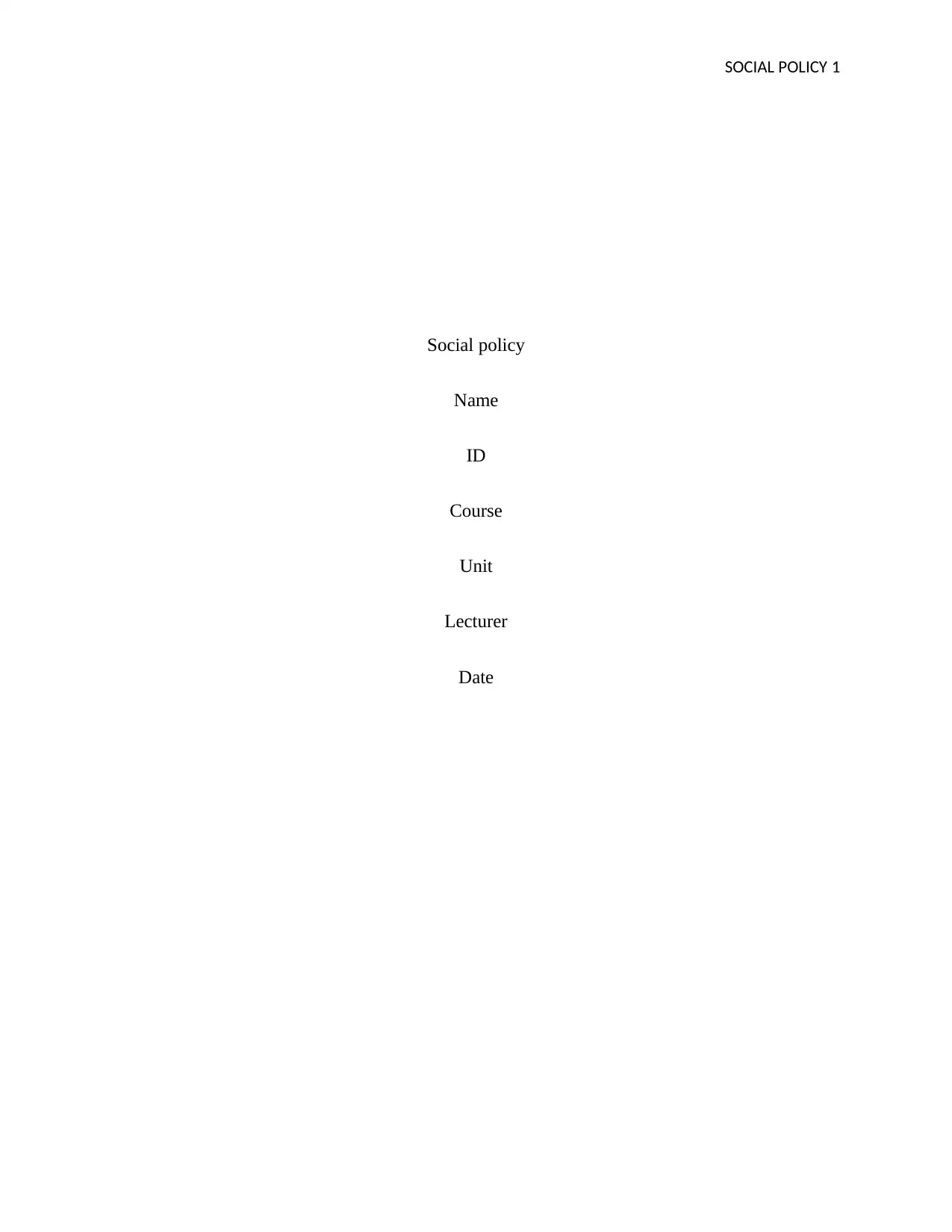
SOCIAL POLICY 1
Social policy
Name
ID
Course
Unit
Lecturer
Date
Social policy
Name
ID
Course
Unit
Lecturer
Date
Paraphrase This Document
Need a fresh take? Get an instant paraphrase of this document with our AI Paraphraser
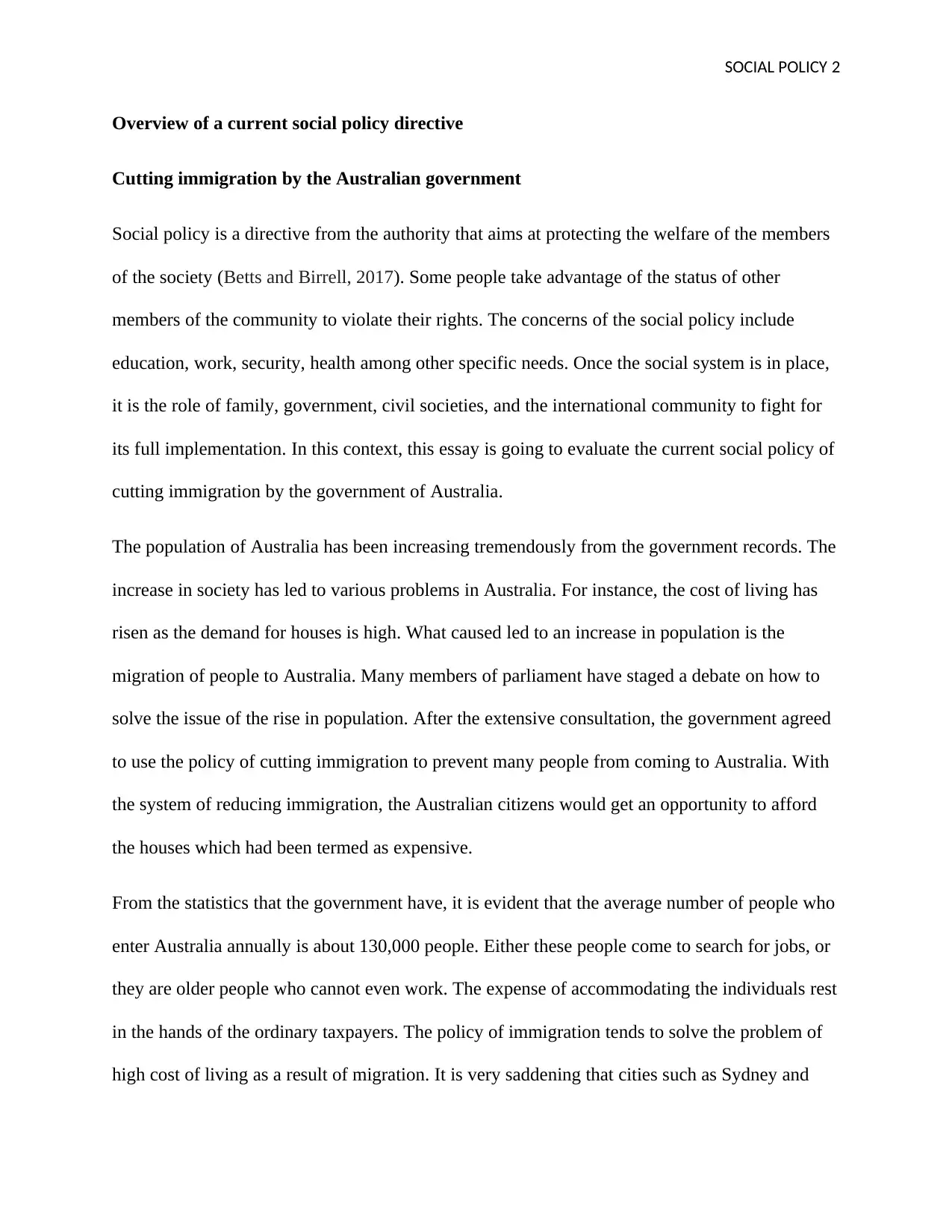
SOCIAL POLICY 2
Overview of a current social policy directive
Cutting immigration by the Australian government
Social policy is a directive from the authority that aims at protecting the welfare of the members
of the society (Betts and Birrell, 2017). Some people take advantage of the status of other
members of the community to violate their rights. The concerns of the social policy include
education, work, security, health among other specific needs. Once the social system is in place,
it is the role of family, government, civil societies, and the international community to fight for
its full implementation. In this context, this essay is going to evaluate the current social policy of
cutting immigration by the government of Australia.
The population of Australia has been increasing tremendously from the government records. The
increase in society has led to various problems in Australia. For instance, the cost of living has
risen as the demand for houses is high. What caused led to an increase in population is the
migration of people to Australia. Many members of parliament have staged a debate on how to
solve the issue of the rise in population. After the extensive consultation, the government agreed
to use the policy of cutting immigration to prevent many people from coming to Australia. With
the system of reducing immigration, the Australian citizens would get an opportunity to afford
the houses which had been termed as expensive.
From the statistics that the government have, it is evident that the average number of people who
enter Australia annually is about 130,000 people. Either these people come to search for jobs, or
they are older people who cannot even work. The expense of accommodating the individuals rest
in the hands of the ordinary taxpayers. The policy of immigration tends to solve the problem of
high cost of living as a result of migration. It is very saddening that cities such as Sydney and
Overview of a current social policy directive
Cutting immigration by the Australian government
Social policy is a directive from the authority that aims at protecting the welfare of the members
of the society (Betts and Birrell, 2017). Some people take advantage of the status of other
members of the community to violate their rights. The concerns of the social policy include
education, work, security, health among other specific needs. Once the social system is in place,
it is the role of family, government, civil societies, and the international community to fight for
its full implementation. In this context, this essay is going to evaluate the current social policy of
cutting immigration by the government of Australia.
The population of Australia has been increasing tremendously from the government records. The
increase in society has led to various problems in Australia. For instance, the cost of living has
risen as the demand for houses is high. What caused led to an increase in population is the
migration of people to Australia. Many members of parliament have staged a debate on how to
solve the issue of the rise in population. After the extensive consultation, the government agreed
to use the policy of cutting immigration to prevent many people from coming to Australia. With
the system of reducing immigration, the Australian citizens would get an opportunity to afford
the houses which had been termed as expensive.
From the statistics that the government have, it is evident that the average number of people who
enter Australia annually is about 130,000 people. Either these people come to search for jobs, or
they are older people who cannot even work. The expense of accommodating the individuals rest
in the hands of the ordinary taxpayers. The policy of immigration tends to solve the problem of
high cost of living as a result of migration. It is very saddening that cities such as Sydney and
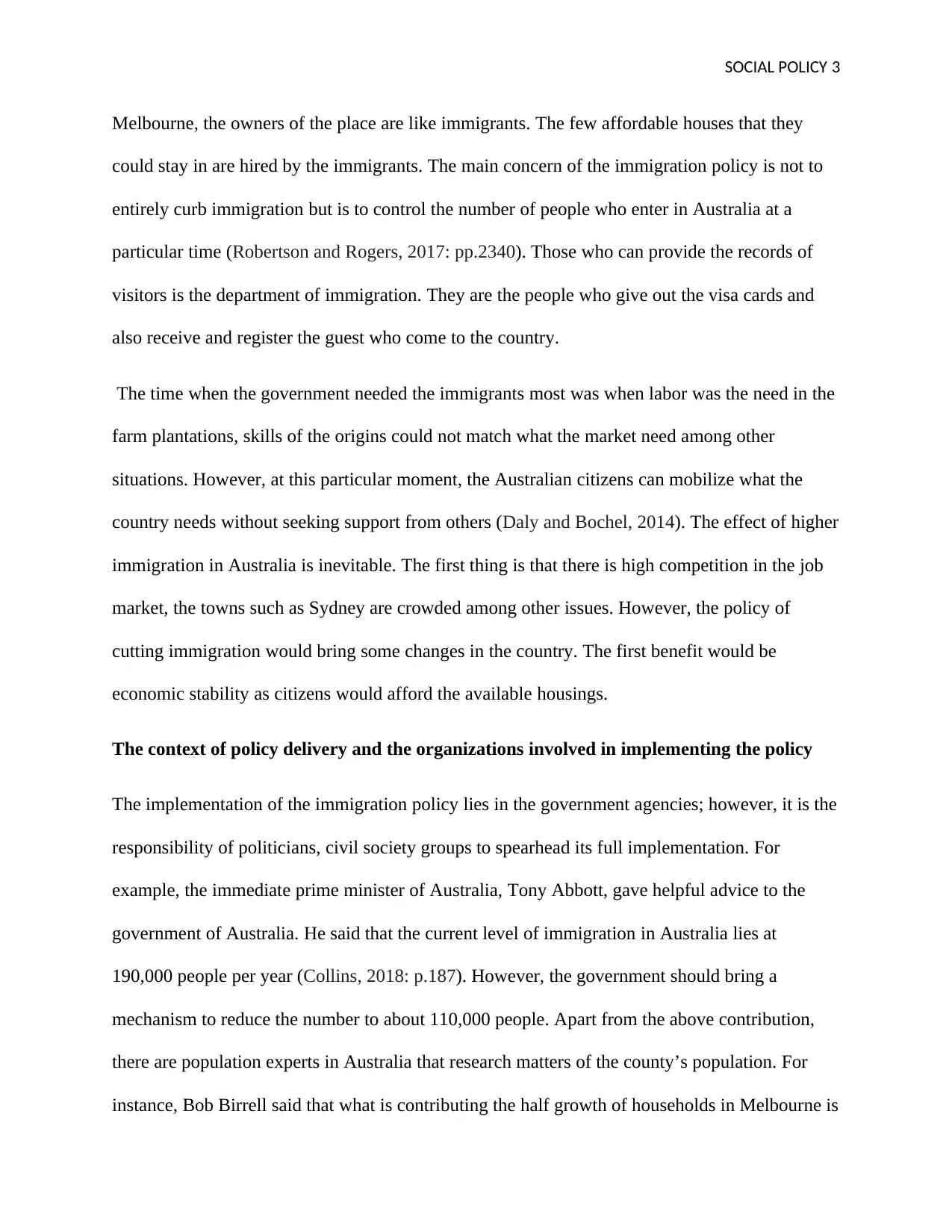
SOCIAL POLICY 3
Melbourne, the owners of the place are like immigrants. The few affordable houses that they
could stay in are hired by the immigrants. The main concern of the immigration policy is not to
entirely curb immigration but is to control the number of people who enter in Australia at a
particular time (Robertson and Rogers, 2017: pp.2340). Those who can provide the records of
visitors is the department of immigration. They are the people who give out the visa cards and
also receive and register the guest who come to the country.
The time when the government needed the immigrants most was when labor was the need in the
farm plantations, skills of the origins could not match what the market need among other
situations. However, at this particular moment, the Australian citizens can mobilize what the
country needs without seeking support from others (Daly and Bochel, 2014). The effect of higher
immigration in Australia is inevitable. The first thing is that there is high competition in the job
market, the towns such as Sydney are crowded among other issues. However, the policy of
cutting immigration would bring some changes in the country. The first benefit would be
economic stability as citizens would afford the available housings.
The context of policy delivery and the organizations involved in implementing the policy
The implementation of the immigration policy lies in the government agencies; however, it is the
responsibility of politicians, civil society groups to spearhead its full implementation. For
example, the immediate prime minister of Australia, Tony Abbott, gave helpful advice to the
government of Australia. He said that the current level of immigration in Australia lies at
190,000 people per year (Collins, 2018: p.187). However, the government should bring a
mechanism to reduce the number to about 110,000 people. Apart from the above contribution,
there are population experts in Australia that research matters of the county’s population. For
instance, Bob Birrell said that what is contributing the half growth of households in Melbourne is
Melbourne, the owners of the place are like immigrants. The few affordable houses that they
could stay in are hired by the immigrants. The main concern of the immigration policy is not to
entirely curb immigration but is to control the number of people who enter in Australia at a
particular time (Robertson and Rogers, 2017: pp.2340). Those who can provide the records of
visitors is the department of immigration. They are the people who give out the visa cards and
also receive and register the guest who come to the country.
The time when the government needed the immigrants most was when labor was the need in the
farm plantations, skills of the origins could not match what the market need among other
situations. However, at this particular moment, the Australian citizens can mobilize what the
country needs without seeking support from others (Daly and Bochel, 2014). The effect of higher
immigration in Australia is inevitable. The first thing is that there is high competition in the job
market, the towns such as Sydney are crowded among other issues. However, the policy of
cutting immigration would bring some changes in the country. The first benefit would be
economic stability as citizens would afford the available housings.
The context of policy delivery and the organizations involved in implementing the policy
The implementation of the immigration policy lies in the government agencies; however, it is the
responsibility of politicians, civil society groups to spearhead its full implementation. For
example, the immediate prime minister of Australia, Tony Abbott, gave helpful advice to the
government of Australia. He said that the current level of immigration in Australia lies at
190,000 people per year (Collins, 2018: p.187). However, the government should bring a
mechanism to reduce the number to about 110,000 people. Apart from the above contribution,
there are population experts in Australia that research matters of the county’s population. For
instance, Bob Birrell said that what is contributing the half growth of households in Melbourne is
⊘ This is a preview!⊘
Do you want full access?
Subscribe today to unlock all pages.

Trusted by 1+ million students worldwide
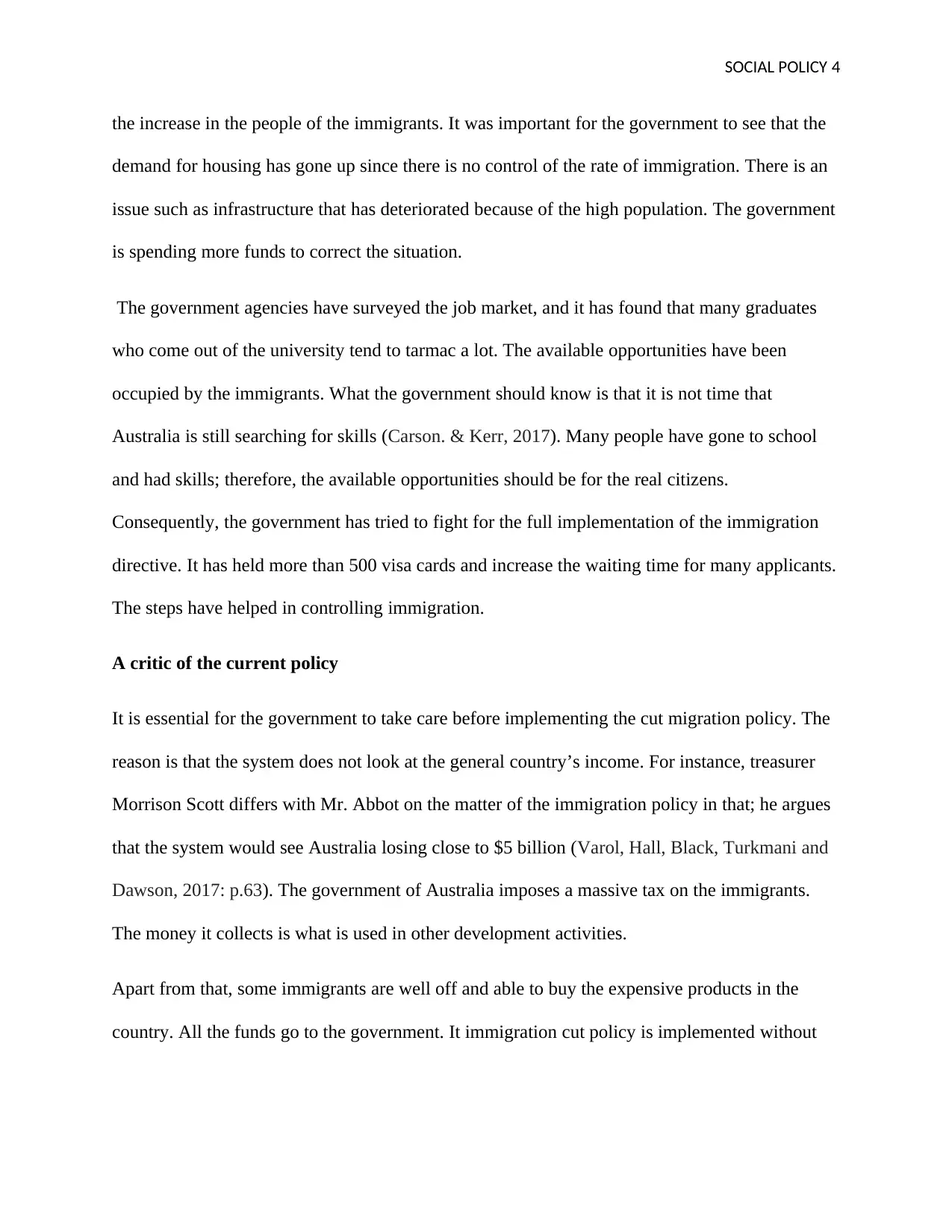
SOCIAL POLICY 4
the increase in the people of the immigrants. It was important for the government to see that the
demand for housing has gone up since there is no control of the rate of immigration. There is an
issue such as infrastructure that has deteriorated because of the high population. The government
is spending more funds to correct the situation.
The government agencies have surveyed the job market, and it has found that many graduates
who come out of the university tend to tarmac a lot. The available opportunities have been
occupied by the immigrants. What the government should know is that it is not time that
Australia is still searching for skills (Carson. & Kerr, 2017). Many people have gone to school
and had skills; therefore, the available opportunities should be for the real citizens.
Consequently, the government has tried to fight for the full implementation of the immigration
directive. It has held more than 500 visa cards and increase the waiting time for many applicants.
The steps have helped in controlling immigration.
A critic of the current policy
It is essential for the government to take care before implementing the cut migration policy. The
reason is that the system does not look at the general country’s income. For instance, treasurer
Morrison Scott differs with Mr. Abbot on the matter of the immigration policy in that; he argues
that the system would see Australia losing close to $5 billion (Varol, Hall, Black, Turkmani and
Dawson, 2017: p.63). The government of Australia imposes a massive tax on the immigrants.
The money it collects is what is used in other development activities.
Apart from that, some immigrants are well off and able to buy the expensive products in the
country. All the funds go to the government. It immigration cut policy is implemented without
the increase in the people of the immigrants. It was important for the government to see that the
demand for housing has gone up since there is no control of the rate of immigration. There is an
issue such as infrastructure that has deteriorated because of the high population. The government
is spending more funds to correct the situation.
The government agencies have surveyed the job market, and it has found that many graduates
who come out of the university tend to tarmac a lot. The available opportunities have been
occupied by the immigrants. What the government should know is that it is not time that
Australia is still searching for skills (Carson. & Kerr, 2017). Many people have gone to school
and had skills; therefore, the available opportunities should be for the real citizens.
Consequently, the government has tried to fight for the full implementation of the immigration
directive. It has held more than 500 visa cards and increase the waiting time for many applicants.
The steps have helped in controlling immigration.
A critic of the current policy
It is essential for the government to take care before implementing the cut migration policy. The
reason is that the system does not look at the general country’s income. For instance, treasurer
Morrison Scott differs with Mr. Abbot on the matter of the immigration policy in that; he argues
that the system would see Australia losing close to $5 billion (Varol, Hall, Black, Turkmani and
Dawson, 2017: p.63). The government of Australia imposes a massive tax on the immigrants.
The money it collects is what is used in other development activities.
Apart from that, some immigrants are well off and able to buy the expensive products in the
country. All the funds go to the government. It immigration cut policy is implemented without
Paraphrase This Document
Need a fresh take? Get an instant paraphrase of this document with our AI Paraphraser
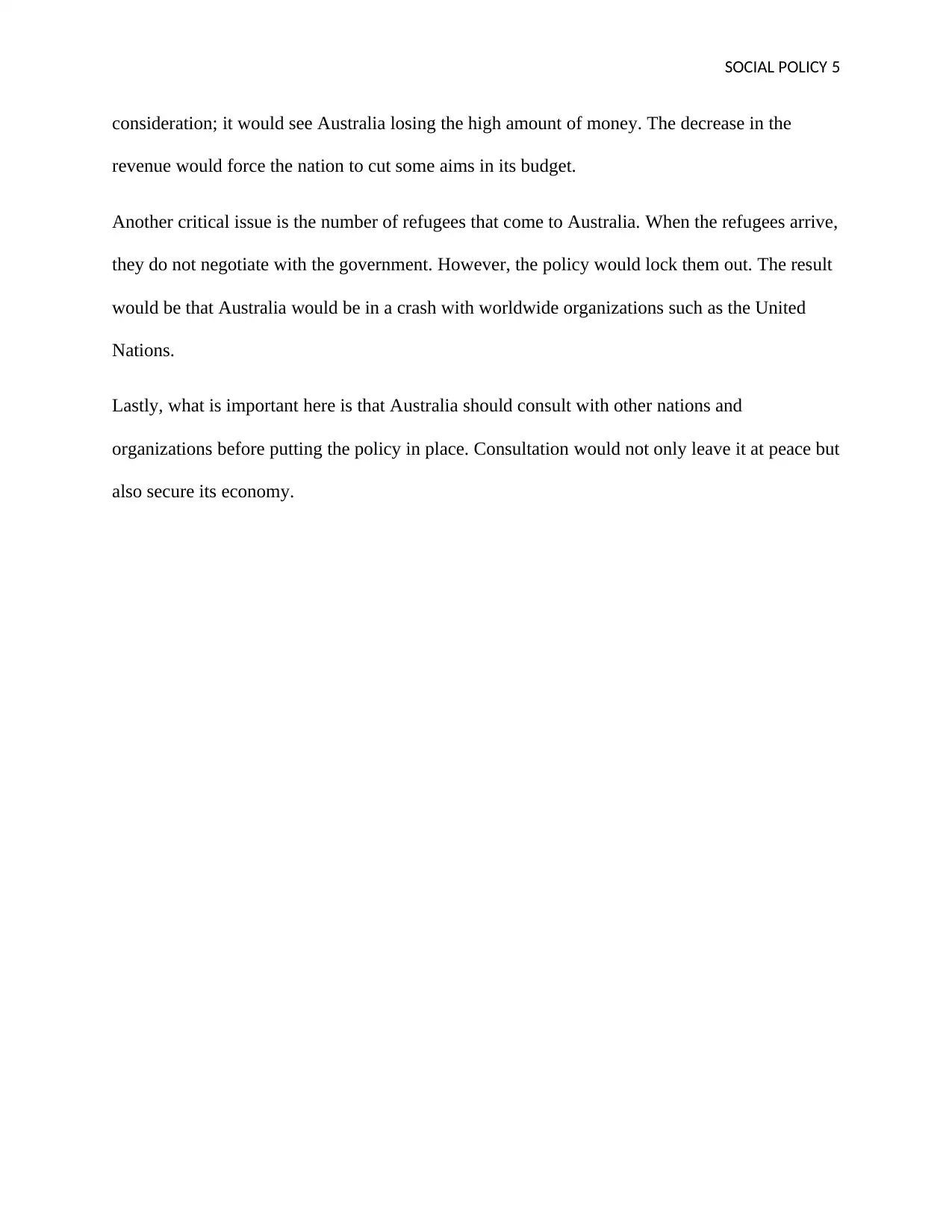
SOCIAL POLICY 5
consideration; it would see Australia losing the high amount of money. The decrease in the
revenue would force the nation to cut some aims in its budget.
Another critical issue is the number of refugees that come to Australia. When the refugees arrive,
they do not negotiate with the government. However, the policy would lock them out. The result
would be that Australia would be in a crash with worldwide organizations such as the United
Nations.
Lastly, what is important here is that Australia should consult with other nations and
organizations before putting the policy in place. Consultation would not only leave it at peace but
also secure its economy.
consideration; it would see Australia losing the high amount of money. The decrease in the
revenue would force the nation to cut some aims in its budget.
Another critical issue is the number of refugees that come to Australia. When the refugees arrive,
they do not negotiate with the government. However, the policy would lock them out. The result
would be that Australia would be in a crash with worldwide organizations such as the United
Nations.
Lastly, what is important here is that Australia should consult with other nations and
organizations before putting the policy in place. Consultation would not only leave it at peace but
also secure its economy.
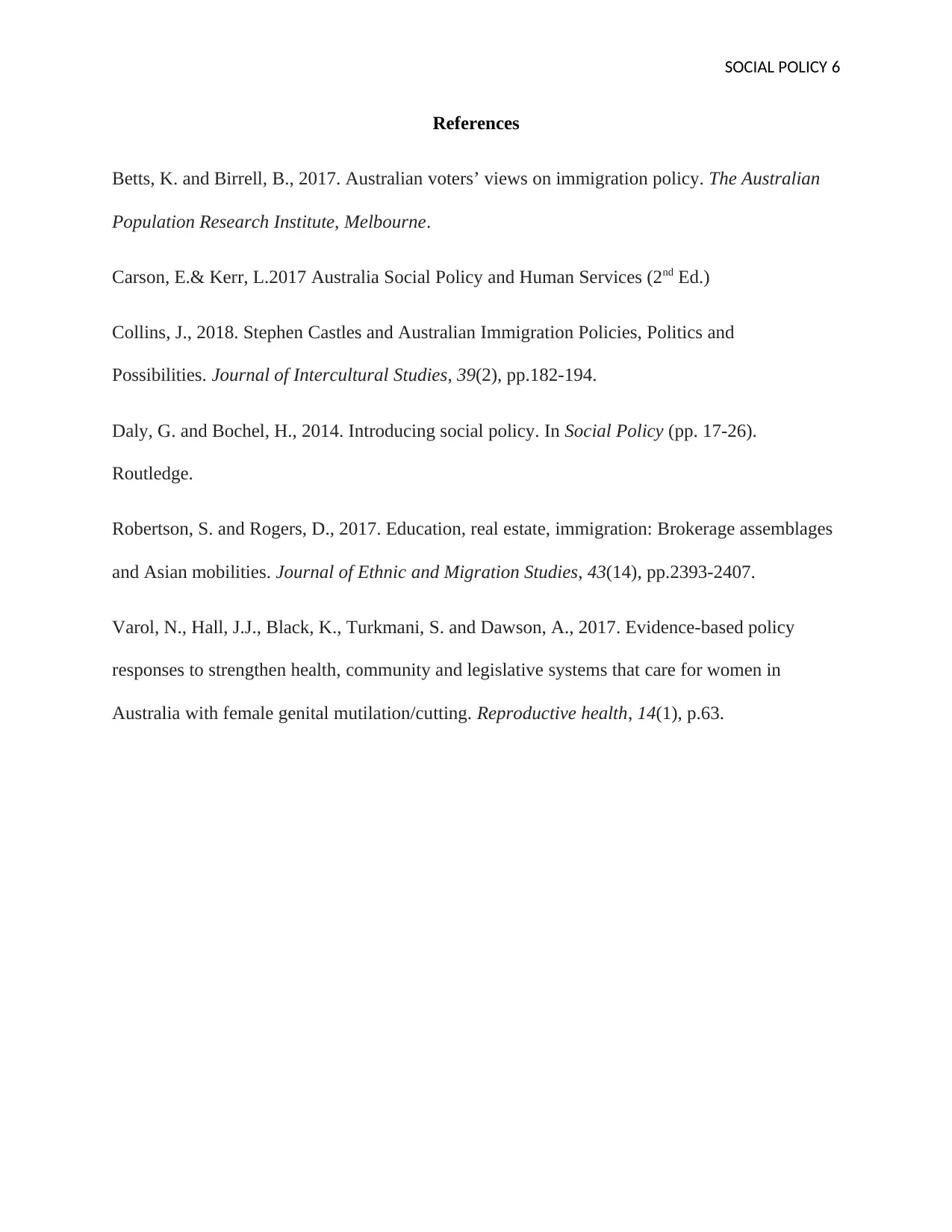
SOCIAL POLICY 6
References
Betts, K. and Birrell, B., 2017. Australian voters’ views on immigration policy. The Australian
Population Research Institute, Melbourne.
Carson, E.& Kerr, L.2017 Australia Social Policy and Human Services (2nd Ed.)
Collins, J., 2018. Stephen Castles and Australian Immigration Policies, Politics and
Possibilities. Journal of Intercultural Studies, 39(2), pp.182-194.
Daly, G. and Bochel, H., 2014. Introducing social policy. In Social Policy (pp. 17-26).
Routledge.
Robertson, S. and Rogers, D., 2017. Education, real estate, immigration: Brokerage assemblages
and Asian mobilities. Journal of Ethnic and Migration Studies, 43(14), pp.2393-2407.
Varol, N., Hall, J.J., Black, K., Turkmani, S. and Dawson, A., 2017. Evidence-based policy
responses to strengthen health, community and legislative systems that care for women in
Australia with female genital mutilation/cutting. Reproductive health, 14(1), p.63.
References
Betts, K. and Birrell, B., 2017. Australian voters’ views on immigration policy. The Australian
Population Research Institute, Melbourne.
Carson, E.& Kerr, L.2017 Australia Social Policy and Human Services (2nd Ed.)
Collins, J., 2018. Stephen Castles and Australian Immigration Policies, Politics and
Possibilities. Journal of Intercultural Studies, 39(2), pp.182-194.
Daly, G. and Bochel, H., 2014. Introducing social policy. In Social Policy (pp. 17-26).
Routledge.
Robertson, S. and Rogers, D., 2017. Education, real estate, immigration: Brokerage assemblages
and Asian mobilities. Journal of Ethnic and Migration Studies, 43(14), pp.2393-2407.
Varol, N., Hall, J.J., Black, K., Turkmani, S. and Dawson, A., 2017. Evidence-based policy
responses to strengthen health, community and legislative systems that care for women in
Australia with female genital mutilation/cutting. Reproductive health, 14(1), p.63.
⊘ This is a preview!⊘
Do you want full access?
Subscribe today to unlock all pages.

Trusted by 1+ million students worldwide
1 out of 6
Related Documents
Your All-in-One AI-Powered Toolkit for Academic Success.
+13062052269
info@desklib.com
Available 24*7 on WhatsApp / Email
![[object Object]](/_next/static/media/star-bottom.7253800d.svg)
Unlock your academic potential
Copyright © 2020–2025 A2Z Services. All Rights Reserved. Developed and managed by ZUCOL.





